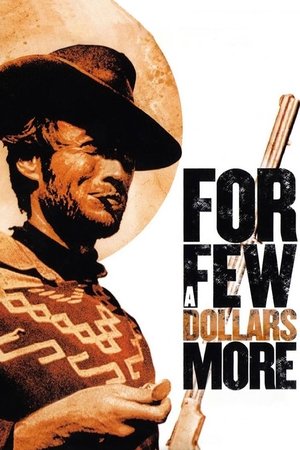
For a Few Dollars More
A spaghetti Cornetto trilogy? 75+% A lone man on horseback is seen travelling slowly towards us from a distance. Soon there is a seemingly senseless act of violence. It isn’t clear to me whether this ‘loose end’ is resolved later on in the film or whether it mainly functions as worldbuilding, for the benefit of the viewer, letting them know how little value human lives have in this place. After the opening credits follow on from this, the film proper begins. We see two men in a train carriage. The face of one is obscured as they are reading the Holy Bible, according to the text on it. We come to know the man with the obscured face as the film unreels. Not really having read any reviews or such like of this film, I wonder if I am the only person to ponder at the end of this man’s journey whether that introduction to him was in earnest or ironic. It’s perhaps hard to tell. After all, Americans see no tension between loving Jesus and loving money, as the ‘prosperity gospel’ theology attests. The main story concerns two independent bounty hunters in America’s frontier, near Mexico. There is uncertainty as to how the two bounty hunters (the film uses the term “bounty killer”) chasing the same bounties will play out. Is conflict inevitable between them? We have a sense of when all this action takes place, as, at a later point in the film, one of the minor characters is part of a humorous scene where we can see the disruptive influence of the recently introduced passenger train service to the region. The early action of the film put in mind video games for me, with how some action games might have small bounties for the player to chase when they first start and increasing in size as the gamer becomes more proficient at taking on their targets and seeks larger rewards to gain better equipment or what have you. As the bounties in the film increase in size, they seem to correlate with “on rails” video games. In other words, I found this film to have more of a sense of linearity to it than its predecessor, “A fistful of dollars”. One of the bounty killers looks familiar for those who have seen “A fistful of dollars”. It’s the character played by Clint Eastwood. So, obviously, there is a physical resemblance of the two characters and perhaps they even dress identically. However, to me they seemed two different characters, as in it’s not the same person. As I mentioned in my review of the earlier film, Eastwood’s character had a playful aspect to him there. In this next film in the sequence, though Eastwood’s character is not exactly humourless, his humour is more wry or sardonic. No, that doesn’t quite capture what I’m wanting to say here. In the first film, ‘Squint’ Eastwood was playful and he shared that quality with at least one other character (I have in mind the ‘hanging around’ scene), whereas in this film Eastwood’s character plays his cards held tightly to his chest. In other words, he is amused by some things but is not letting on to anyone else that he is (I have in mind the scene I mentioned earlier, with the minor character talking about the impact of the introduction of trains on him). Wikipedia mentions these first two films being part of a trilogy: “The dollars trilogy” or “The man with no name trilogy”. Since I don’t find myself considering the Clint Eastwood character in both films that I’ve seen so far to be the same person, I’m leaning towards taking these films as being like “The Cornetto trilogy”, in that they are three unrelated films with the same principle actors and loosely bound together. I have to admit to being totally clueless about this “Cornetto trilogy”, despite having seen the first two: “Shaun of the dead” and “Hot fuzz”. Apparently all three films make passing mention of Cornetto ice creams. That is what makes them a ‘trilogy’. Perhaps Clint Eastwood’s poncho is Sergio Leone’s Cornetto counterpart? Maybe the third film in this ‘trilogy’ will prove me wrong but it doesn’t seem a “trilogy” at the moment like the Star Wars films are. An interesting facet to these first two films of the ‘trilogy’ that I have seen so far is how one is supposed to relate to returning actors. As I’ve said, I’m viewing Clint Eastwood’s characters as being different. Another returning actor is Gian Maria Volonté, who once again plays the principle villain of the piece, although he is clearly a different character in both. He must necessarily, of course, be of the same ethnicity. In any case, we have two archetypes in common for both films: the poncho wearing man with no name and the swarthy villain. An action archetype in both films is a scene with a beating, although the one in the first film was the more brutal, I think. The only other returning actor that I noticed was Joseph Egger. Since this paragraph and below was written a couple of weeks after I started this review, things like this aren’t fresh in my memory, unfortunately. Speaking of men with no name, in this film, ‘Squint’ Eastwood’s character is referred to as “Manco” and it seemed to be an actual name to me. The translation app on my PC translates this variously as “one-armed” (for Spanish and Italian) or “not even” (for Latin). Not sure how good my translation app is but it’s not really clear to me how Clint’s character is “one-armed”. When the film concludes, there is a sort of ‘maybe, kind of, not really’ ambiguity to it. There probably really isn’t, as far as what that character would do in that situation, after retrieving a certain item. It’s just good that the film ends there and you are free to ponder what that character will do with that item. Random notes: * I’m scoring this film 75+% (since I don’t round up, the + sign adds an extra star to my rating here). This film has more implausibility to it than the first film which makes it harder for me to get lost in the story. The main way this is demonstrated is how characters interact with each other. I couldn’t believe that Manco would accept a proposition from his rival to do something, as that set off alarm bells for me, as far as possible double-crosses go. Likewise, Manco getting accepted for a heist. Character motivations and actions often just didn’t seem believable to me. * Ennio Morricone is credited for the score, unlike in the first film, where, for some reason, he is credited as “Dan Savio”. As far as dramatic music goes, this feels his best score so far, especially effective with the percussive textures during the El Paso bank robbery scene. One thing niggling at me is that I can’t place what other piece of music some parts reminded me of. A few notes perhaps put in mind some 1960’s surf-rock song...maybe something by The Shadows but maybe something else which I can’t recall at the moment (the scene leading up to the bank robbery). A flashback scene has some eerie music. After the robbery scene, I wonder whether I hear the words “Go! Go! Go!” as part of the score...it sort of sounds like words are being used but maybe they’re just meant to be suggestive vocalisations? More toward the start of the film, it sounds like the vocalisations are “We can ride!”. * There is an odd mix of childlike depictions of violence (which are perhaps more Classical Hollywood Western in style, although I have not seen too many of these and not since I was a child in any case) and more realistic depictions of the consequences of violence. So, you will see a man fall to the ground after being shot but the shooter’s gun was facing toward the ground, not the victim. And the victim does not bleed. On the other hand, on very rare occasions you will see graphic bullet wounds in freshly made corpses. It therefore seems like a transitional moment in cinema between these two styles...sort of like The Wizard Of Oz was for black/white and colour films, perhaps. * There’s a scene where Manco forces an occupant of a hotel room to leave, so that he can have that room for himself. For me, this reflected badly on his character. * Architecture...when Indio’s gang enters El Paso, one of the first buildings looks like a prop, as far as the first storey goes. The “Cosmopolitan Theatre” has the UK spelling convention. Of more interest, it looked to me like a heavily secured internal section of the El Paso bank had an unsecured window at its heart...but maybe we can rationalise this by thinking that the bank is as weird as The Overlook Hotel in Kubrick’s film The Shining? One shot of a town’s main street made me wonder if it was shot in a studio, probably due to weather effects. * The fight scene between two bounty hunters is very formal, stylised and ritualistic. Not that there’s anything wrong with that! This contrasts with another scene in the film which put in mind Jon Pertwee era Doctor Who fight scenes, with the Doctor’s risible ‘Venusian karate’ (just looked that up for the term. In any case, it looks pretty harmless!). \ * Print quality: sometimes bits of film seemed to be missing. Maybe you’d see a white patch on Mr. Mortimer’s face. Another time the effect is cooler, as the missing film makes it look the fresh corpse has a bullet hole. * Just the random nature of the morality in this film...some actions seem to conform to a moral code but then the same character can do many greatly immoral things. Hmm. People are strange. Recorded on 10/10/2024 at 9:35pm SBS World Movies. Running time of c 2:06:12 hours, without 5 lots of ad breaks, which increased it’s running time to c 2:24:42 hours. In both cases, I edited to the start of the MGM lion’s roar before the film started to the end of its roar at the conclusion of the film. Viewed 16-17/11/2024. Rated M for violence and AD (audio described) which once again meant, unfortunately, that were no closed captions.
